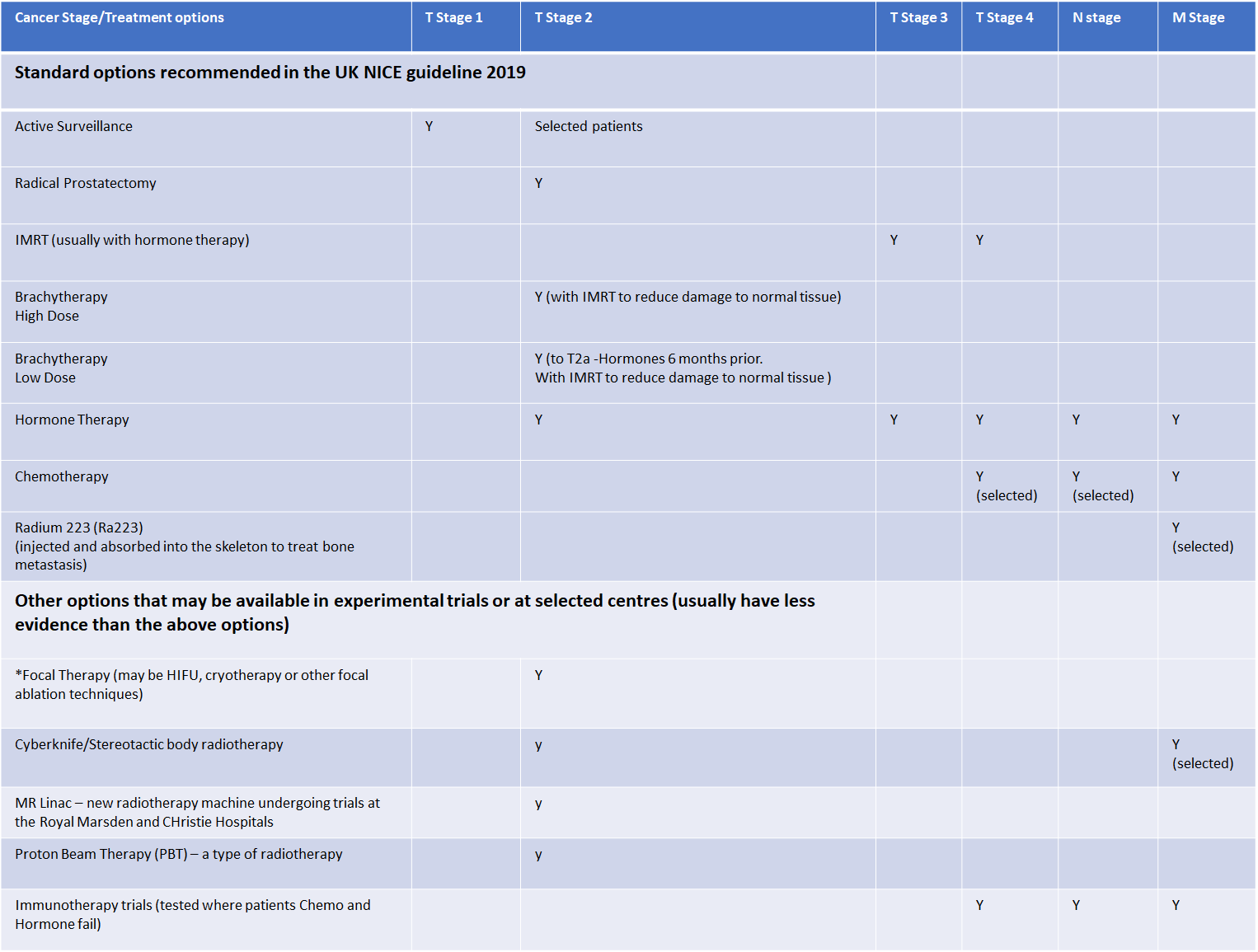Determining Prostate cancer treatment options
Overview by Overview by Dr Alison Tree
Consultant Clinical Oncologist
The Royal Marsden
Team Leader Uro radiology research including MR Linac PRISM The Institute of Cancer Research, London

A high level view of all the prostate cancer treatment options that might be suitable for a patient depending the severity and spread of the cancer.
This is a guide, only a clinical expert following an Multi Disciplinary Team (MDT) meeting between specialist physicians can determine the treatments most applicable to a particular patient. Currently in New Zealand Focal Therapy has not been approved for use outside of clinical trials and is not offered.
It is recommended you read about the Gleason score and staging the severity of the cancer before reading this page. There pages describing each of the treatments.
The chart and key can be downloaded as a PDF.

As MR Linac is only just becoming available, it will probably be applied with the same protocols as IMRT and SBRT (Cyberknife).
Proton Beam Therapy (PBT) is now available at the Rutherford Cancer Centres, but their is no evidence it is superior in outcomes to IMRT.
*Focal therapy. HIFU =prostates up to 40cc and Posterior tumours, Cryotherapy =Anterior tumours. Nanoknife is also an option. HIFU can be used as a salvage therapy for local recurrent cancer up to T2c if radiotherapy (IMRT) fails.
** IMRT, Cyberknife, MR Linac and PBT are used if the patients health or preferences preclude radical prostatectomy
T1 – Cancer present, but not detectable in DRE or on imaging.
- T1a – Found incidentally, Less than 5 percent of sample malignant and low-grade.
- T1b – Found incidentally, More than 5 percent of sample malignant and/or not low-grade.
- T1c – PSA elevated, not palpable, found in needle biopsy.
T2 – Tumor is palpable in DRE; organ confined.
- T2a – Confined to half or less than half in one of the prostate’s two lobes.
- T2b – Confined to more than one half of one lobe of gland but not both.
- T2c – The tumor is in both lobes but within the prostatic capsule.
T3 – Locally extensive cancer.
- T3a – Penetration of prostate capsule on one or both sides.
- T3b – Invasion into the seminal vesicle.
T4 – Tumor extension to other organs.
- T4a – Cancer that has invaded the bladder neck and/or rectum and/or external urinary sphincter.
- T4b – Cancer that involves other areas near the prostate.
N – Lymph node involvement.
- N1 – Cancer spread to one or more lymph nodes measuring less than 2cm.
- N2 – Cancer spread to one or more lymph nodes measuring 2-5cm.
- N3 – Cancer spread to one or more lymph nodes measuring more than 5cm.
M – Metastasis to distant sites other than lymph nodes (cancer spread).
- MO – Cancer that is confined to the prostate, surrounding tissues and pelvic lymph nodes.
- M1 – Cancer that has spread beyond the pelvic area to bones, lungs, etc
As further prostate cancer treatment options become available they will be added to the table.

Prostate matters is a not for profit organisation that is committed to providing free expert advice about prostate issues from leading Clinical Authorities
PROSTATE MATTERS
FOLLOW US
Copyright Disclaimer: We try to acknowledge copyright as appropriate. If we have used something without acknowledging copyright, this is inadvertent. Please let us know by emailing info@prostatematters.co.uk


